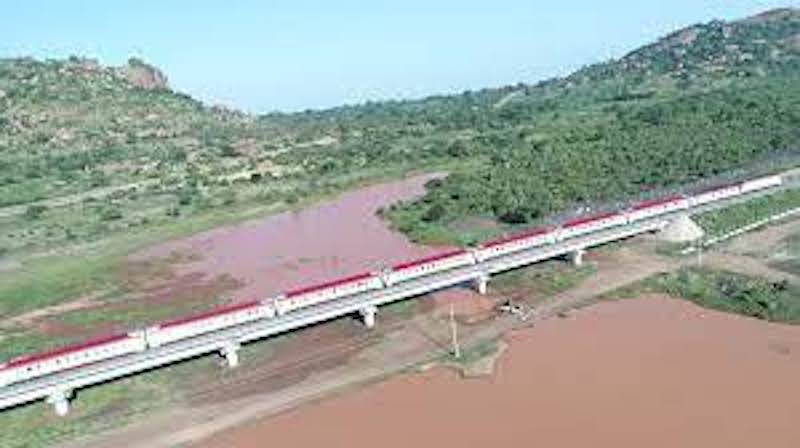Standard Gauge Tracks In Railway Infrastructure
Railway systems are essential to the movement of goods and people across countries and continents. This they play a vital role in transportation and logistics. Gauge is the distance between the inner sides of two parallel rails. Among the various components of a railway system, this defines the size and stability of the tracks. Over time, different countries adopted varying gauges. But one particular gauge, known as the standard gauge, has become the most widely used across the world. This article delves into what they are, their significance and advantages. It also delves into why they have become the benchmark in modern railway infrastructure.
Standard gauge tracks
The term standard gauge tracks refers to a measure of 1,435 millimetres between the inner sides of the rails. This measurement is the most efficient and practical gauge for rail transport and about 60% of the world’s railways it. George Stephenson, a British engineer laid the groundwork for modern rail transport. It was him who introduced the concept of a standard gauge in the early 19th century. His design for the railways in Britain soon spread to other parts of the world, leading to its widespread adoption.
You can now find them in a majority of countries, including the United States, China, most of Europe. Parts of Africa and Asia have also started using them. These tracks are versatile and people use them for both passenger and freight trains. Due to their ability to support high-speed and heavy-load trains, they are often the optimal choice for modern railway systems.
Origins of standard gauge tracks
The development of railway gauges is deeply rooted in the early days of industrialization. In the 1800s, different regions and countries used various gauges based on local needs and the specific industries they served. Some countries used narrow gauge tracks, while others opted for broader gauges to accommodate different types of locomotives and cargo.
George Stephenson and his contemporaries initially designed the standard gauge to meet the industrial needs of Britain. Stephenson conducted a pioneering work on the Stockton and Darlington Railway in 1825. Later on, he did the same in the Liverpool and Manchester railway. This established the 1,435 mm gauge as a practical and efficient standard. His choice of this specific measurement was based on the width of horse-drawn coal wagons used in mines, which had proven to be stable and reliable.
As railways expanded globally, the British empire, with its vast colonial reach, exported this standard gauge to many of its colonies. Over time, this gauge became the de facto standard for much of the world, particularly as nations began to realize the benefits of a unified railway system. The use of different gauges across regions presented operational challenges, especially at national borders, where goods and passengers had to switch between different rail networks. Its adoption helped mitigate these issues and promoted better connectivity and efficiency.
Advantages
Standard gauge tracks offer a wide range of advantages that have contributed to their dominance in global rail systems. These benefits include:
1) Higher speed and stability
The primary reason standard gauge tracks have become so popular is their ability to support higher speeds without compromising stability. The wider gauge compared to narrow-gauge railways allows for smoother and faster operation, especially in passenger trains. This is critical for modern high-speed rail networks, which demand greater track stability to ensure safety at high velocities.
Countries like Japan, France, and China have successfully implemented standard gauge tracks in their high-speed rail systems. For instance, the Shinkansen in Japan and the TGV in France operate on standard gauge tracks, achieving speeds of up to 320 km/h and higher. The inherent stability provided by the standard gauge track ensures that the trains can operate at these speeds with minimal risk of derailment.
2) Compatibility and interoperability
The global acceptance of standard gauge tracks has led to increased compatibility and interoperability between railway systems in different countries. When countries adopt the same gauge, it becomes much easier to transfer rolling stock across borders without requiring costly changes or additional infrastructure.
For instance, in Europe, where many countries share borders and engage in cross-border trade, the use of standard gauge tracks facilitates the smooth transport of goods and passengers between nations. A train can travel from France to Germany or Spain without needing to change its wheels or transfer cargo at border stations. This interoperability reduces operational costs and enhances the efficiency of international railway services.
3) Cost efficiency
Standard gauge tracks are also known for being cost-efficient. Because they are so widely used, the manufacturing of components such as rails, ties, and rolling stock is standardised, leading to economies of scale. When the majority of countries use the same gauge, it drives down production costs for railway equipment, making it more affordable for countries to develop and maintain their railway infrastructure.
Furthermore, the standard gauge allows for the use of heavier and longer trains, increasing the volume of goods that can be transported in a single trip. This improves the cost-effectiveness of freight operations, making rail transport a more attractive option for businesses.
4) Flexibility for different types of trains
Standard gauge tracks are highly versatile and can accommodate a wide variety of trains, from high-speed passenger trains to heavy freight trains. This flexibility is one of the key reasons why the standard gauge has become the global benchmark.
Freight trains that carry heavy loads such as coal, steel, or industrial equipment benefit from the strength and durability of standard gauge tracks. At the same time, passenger trains designed for comfort and speed can also use the same tracks, making the infrastructure more adaptable to different needs. Whether the focus is on long-distance travel, urban commuting, or cargo transport, standard gauge tracks provide the necessary support for all these operations.
Global impact of standard gauge tracks
The widespread adoption of standard gauge tracks has had a profound impact on global rail transportation. As more countries opt for this gauge, the benefits of compatibility, speed, and efficiency continue to grow. Some of the notable regions where standard gauge tracks have transformed railway operations include:
1) Europe
Europe is a region that has fully embraced standard gauge tracks, particularly in its high-speed and cross-border railway networks. The European Union’s emphasis on building a unified and integrated rail system is made possible by the use of standard gauge tracks. Trains such as the Eurostar, which connects the United Kingdom to France via the Channel Tunnel, and the ICE trains in Germany, all operate on standard gauge tracks.
Trans-European transport network is a strategic initiative that aims to create a fully integrated railway network across the continent. Standard gauge tracks are critical to achieving this goal, as they enable seamless travel across different countries without the need for adjustments or delays at borders.
2) China
China has invested heavily in its railway infrastructure over the past few decades, with standard gauge tracks serving as the foundation for its expansive network. China Railway High-speed system, which operates some of the fastest trains in the world, relies on standard gauge tracks to deliver high-speed services across the country.
China’s Belt and Road Initiative also includes plans for extending its railway networks to other parts of Asia, Europe, and Africa, with standard gauge tracks playing a central role in these projects. By exporting its railway technology and expertise, China is helping other countries develop their own standard gauge railways, further increasing the gauge’s global reach.
3) Africa
In Africa, standard gauge tracks are being adopted in several countries as part of modernisation efforts. Standard gauge railway in Kenya, for example, connects Nairobi to the port city of Mombasa and is part of a broader plan to develop a regional rail network across East Africa. Uganda, Tanzania, and Rwanda are all expected to adopt standard gauge tracks in their railway development projects.
The use of standard gauge tracks in Africa is seen as a game-changer for the region’s infrastructure, as it will enable more efficient and reliable transport of goods and passengers. This, in turn, boosts trade and economic growth across the continent.
Future of standard gauge tracks
As the demand for efficient and high-capacity transport continues to grow, the future of standard gauge tracks looks promising. Advances in railway technology, such as the development of magnetic levitation trains and hyper loop systems, may eventually lead to new types of tracks, but for now, the standard gauge remains the backbone of the global rail industry.
In many developing countries, the construction of new standard gauge railways is a key component of national development strategies. The potential for economic growth, improved logistics, and greater connectivity makes the investment in standard gauge tracks an attractive proposition for governments and private sector stakeholders alike.
Additionally, there are ongoing efforts to reduce the environmental impact of transportation. This is likely to further enhance the importance of standard gauge tracks. Railways are generally more energy-efficient and produce fewer carbon emissions than road or air transport. This makes them a key part of global strategies to combat climate change. By expanding standard gauge networks, countries can contribute to more sustainable transportation solutions.
Transportation needs
Tracks have become the global yardstick in railway infrastructure for good reason. They have the ability to support high-speed, stable, and efficient transportation. This has made them the preferred choice for both passenger and freight rail systems around the world. Countries continue to invest in their railway networks. Therefore, the use of these tracks ensures compatibility, cost-efficiency, and flexibility in meeting diverse transportation needs. Standard gauge tracks provide the foundation for a modern and integrated rail system that drives economic growth and enhances connectivity on a global scale.





